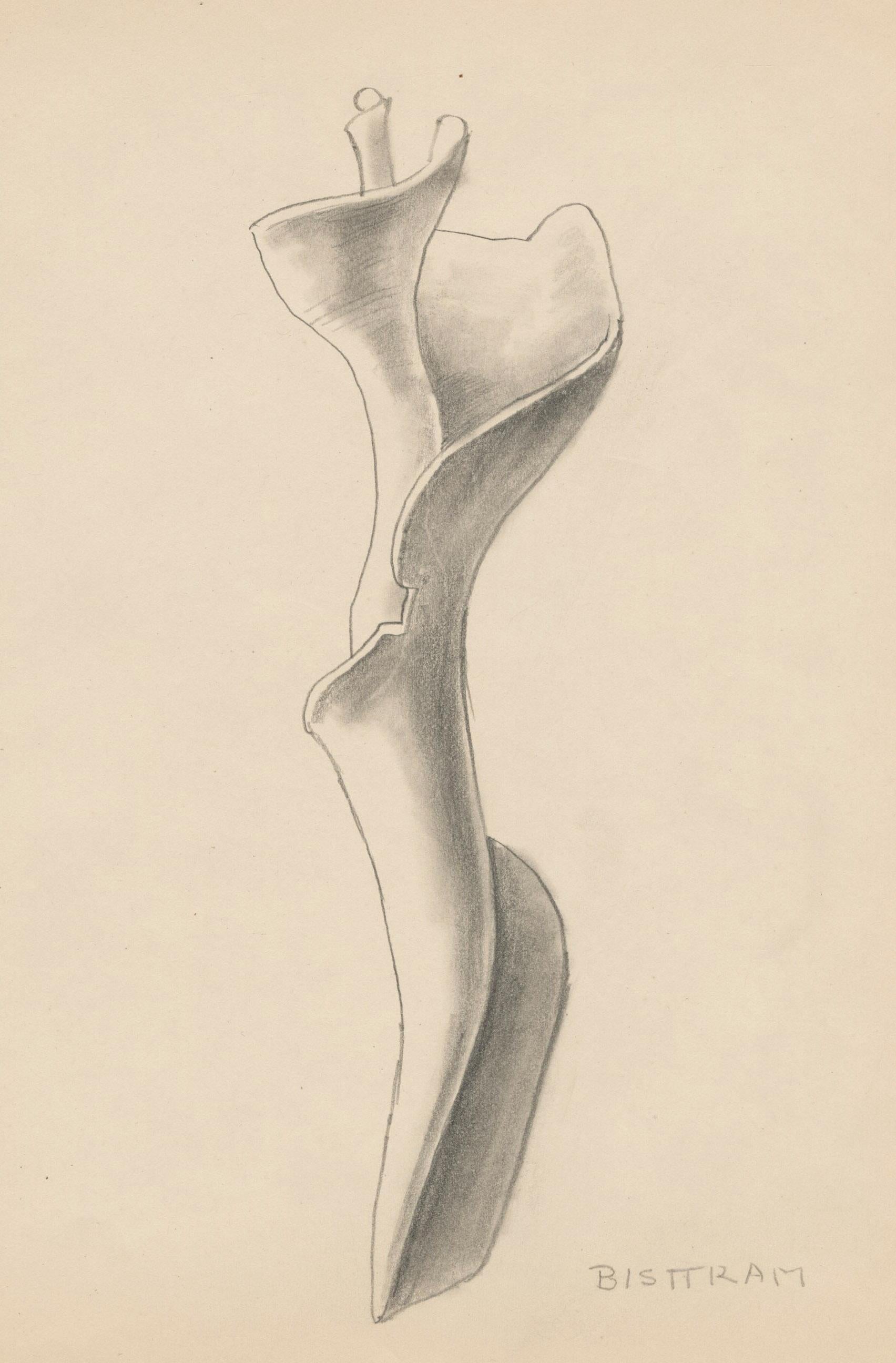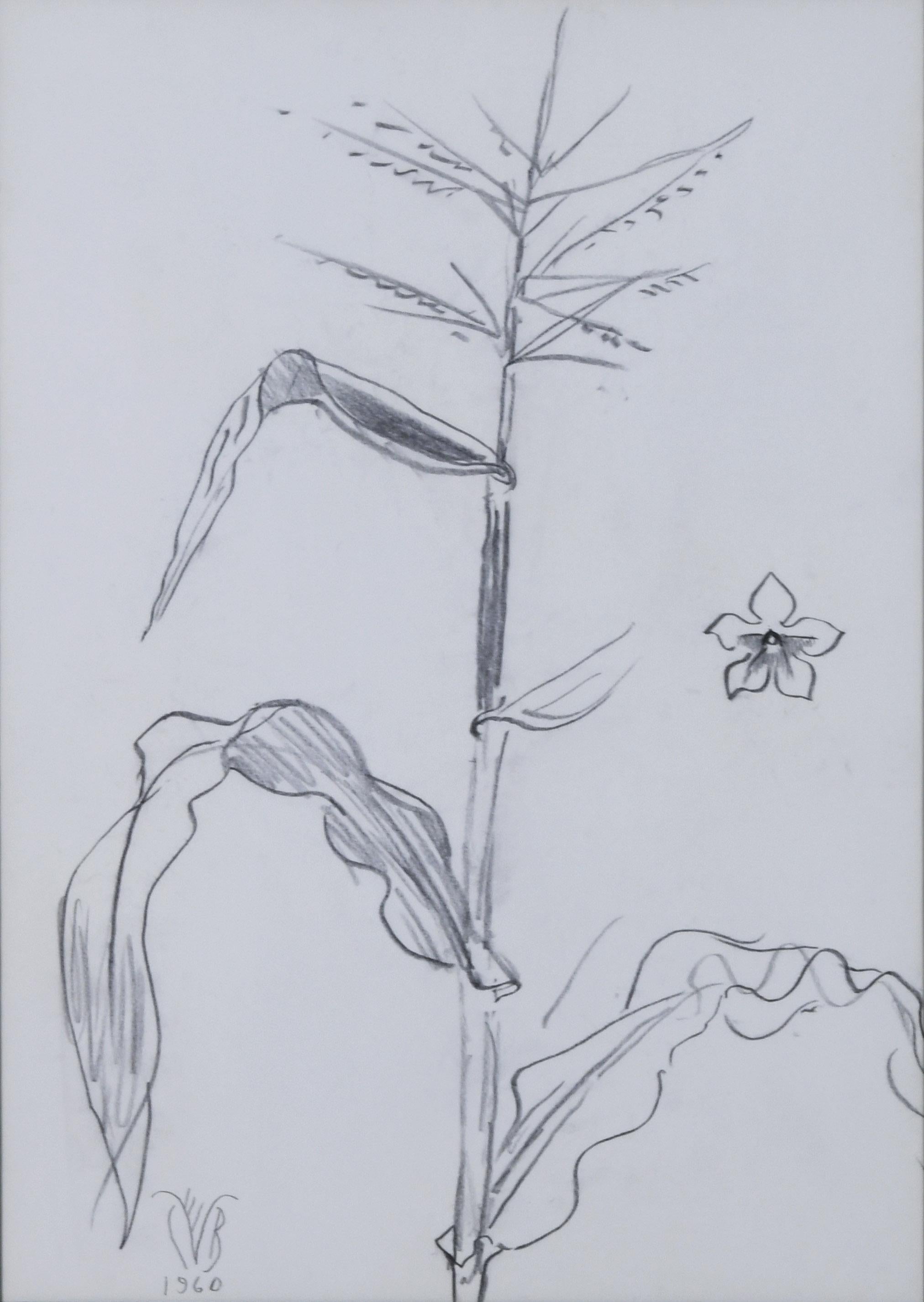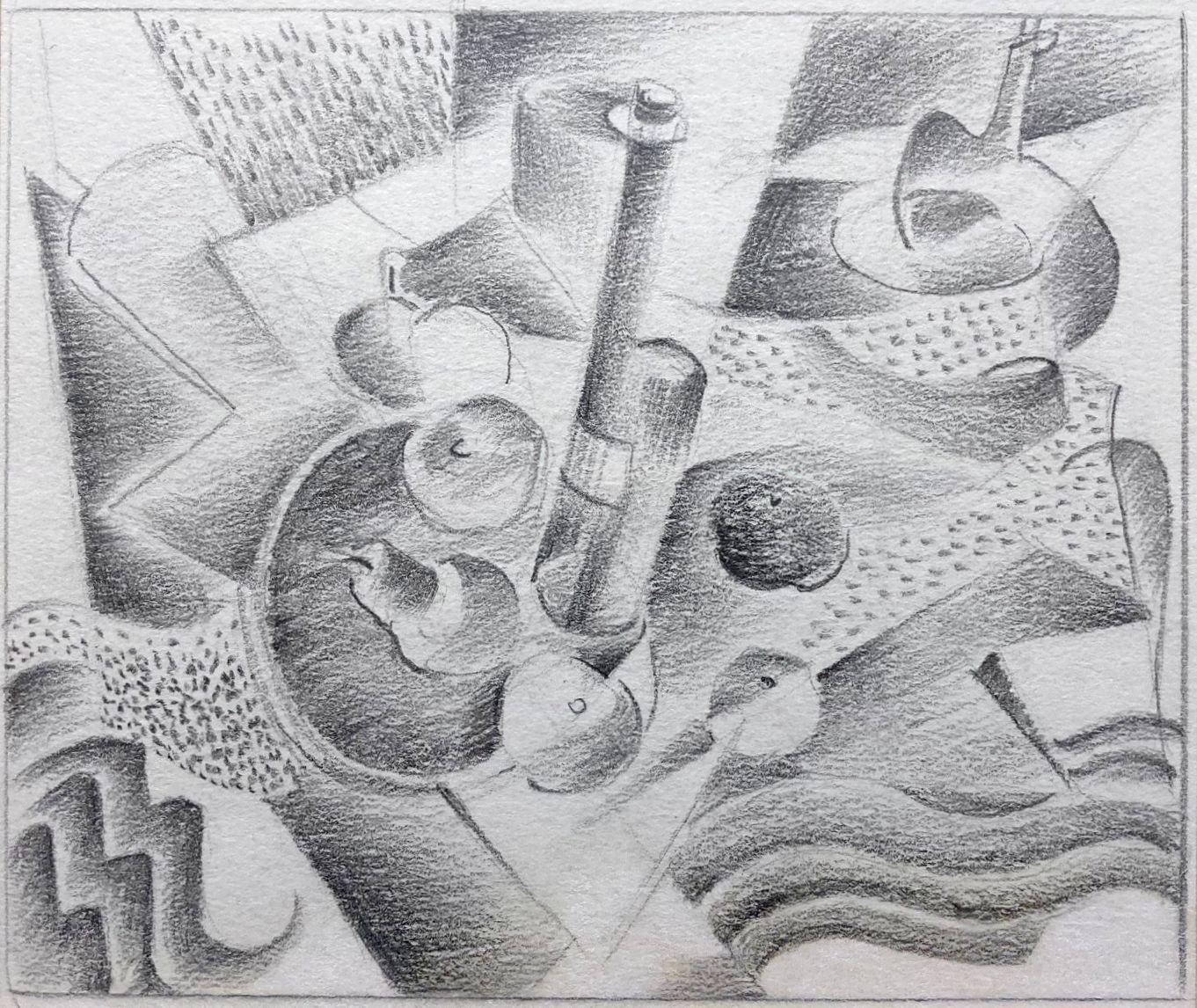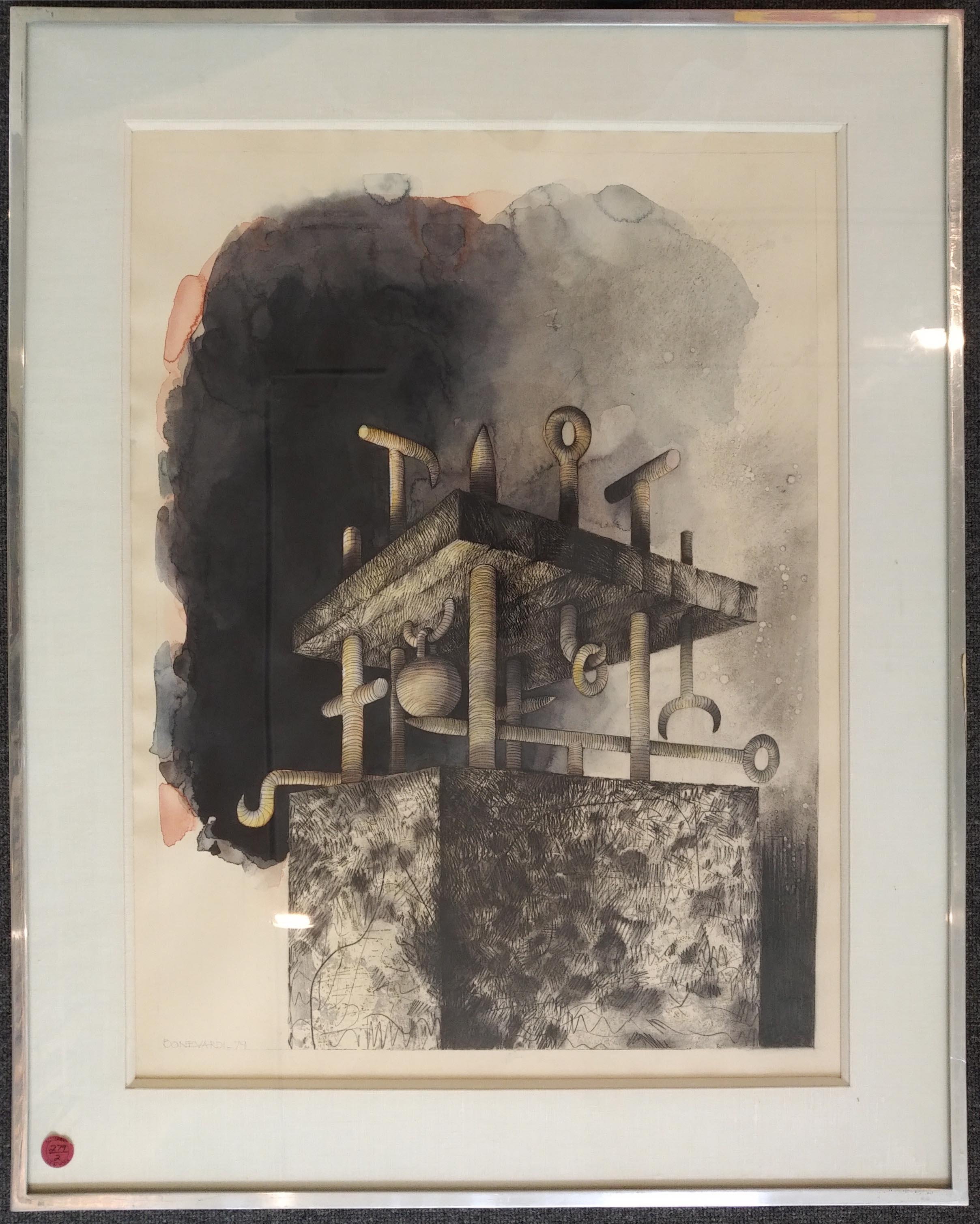Want more images or videos?
Request additional images or videos from the seller
1 of 8
George RickeyPencils and Pens1987
1987
About the Item
Pencils and Pens
Graphite on paper, 1987
Signed and dated by the artist lower right (see photo)
Condition: Excellent
Image/Sheet size: 13 5/16 x 10 11/16 inches
Rickey, a noted kinetic sculptor, was born in South Bend, Indiana. His father moved the family to Scotland. Rickey studied art in England and became an excellent draftsman. He exhibited his drawings late in his career.
Rickey's drawing are rare, usually being preliminary designs for his sculptures. A finished drawing like this example shows the artist's draftsmanship.
"Born in South Bend, Indiana, in 1907, Rickey was raised near Glasgow, Scotland. His father, a mechanical engineer, managed the Singer sewing machine company's branch in Great Britain. Rickey read modern history at Balliol College, Oxford, took classes in drawing at the Ruskin School, then studied painting in Paris at André Lhote's academy and at the Académie Moderne with Fernand Léger and Amédée Ozenfant.
During the 1930s he painted first in a Cézannesque style, later in a Depression-era, social realist mode. He supported himself by teaching at Groton and at a series of colleges and universities.
In World War II Rickey served in the Army Air Corps, testing computing instruments used by bomber gunners. The work required both mechanical skill and understanding the effects of wind and gravity on ballistics, laying the foundation of his move from painting to kinetic sculpture.
Under the G.I. Bill, Rickey studied at the Institute of Fine Arts at New York University and from 1948-1949 attended the Institute of Design in Chicago, an outpost of Bauhaus teaching. Intrigued by both the history of constructivist art and by the mobiles of Alexander Calder, he began creating kinetic sculptures. In the 1950s and early 1960s, Rickey developed systems of motion for his sculpture that responded to the slightest variation in air currents. Over the next three decades he developed sculpture with parts made of lines, planes, rotors, volumes, and churns, moving in paths that change from simple oscillation to conical gyrations, describing a variety of planes or volumes. Many works during this period have been large-scale public commissions for sites in the United States, Europe, and Japan. Rickey died at his home in St. Paul, Minnesota, on 17 July 2002 at the age of 95." Courtesy National Gallery of Art
- Creator:George Rickey (1907-2002, American)
- Creation Year:1987
- Dimensions:Height: 13.94 in (35.41 cm)Width: 10.69 in (27.16 cm)
- Medium:
- Movement & Style:
- Period:
- Condition:
- Gallery Location:Fairlawn, OH
- Reference Number:
About the Seller
5.0
Recognized Seller
These prestigious sellers are industry leaders and represent the highest echelon for item quality and design.
Platinum Seller
These expertly vetted sellers are 1stDibs' most experienced sellers and are rated highest by our customers.
Established in 1978
1stDibs seller since 2013
710 sales on 1stDibs
Typical response time: 1 hour
Associations
International Fine Print Dealers Association
- ShippingRetrieving quote...Ships From: Fairlawn, OH
- Return PolicyA return for this item may be initiated within 10 days of delivery.
More From This SellerView All
- Untitled, Still Life of ShellLocated in Fairlawn, OHUntitled, Still Life of Shell Graphite on paper, 1945-1951 Signed lower right in pencil "Bisttram" (see photo) Condition: Excellent Sheet size: 9.63 x 7 .5 inches EMIL BISTTRAM (189...Category
1940s American Modern Still-life Drawings and Watercolors
MaterialsGraphite
- Study of Corn with NicotainaBy Charles E. BurchfieldLocated in Fairlawn, OHStudy of Corn with Nicotaina Signed with the artist's monogram and dated lower left Crayon on paper laid down on support paper by the artist Inscribed with title, date and dimensions...Category
1960s American Modern Still-life Drawings and Watercolors
MaterialsGraphite
- Untitled (cacti)By Peter MarksLocated in Fairlawn, OHProvenance: Estate of the Artist Peter Marks (1935 -2010) Peter Marks was born in New York City on January 18, 1935. A lifetime New Yorker, Marks gradu...Category
Early 2000s Abstract Geometric Still-life Drawings and Watercolors
MaterialsGraphite
- Flower StudiesBy Mary SpainLocated in Fairlawn, OHUnsigned Graphite and colored pencils on laid paperCategory
Mid-20th Century Surrealist Still-life Drawings and Watercolors
MaterialsColor Pencil, Graphite
- untitled (Still Life with Apples and Vase of Flowers)By William SommerLocated in Fairlawn, OH[recto];untitled (Sketches for Still Unsigned 9 1/2 x 12 inches (24.2 x 30.6 cm.)Category
20th Century Still-life Drawings and Watercolors
MaterialsGraphite
- Surrealist landscape with skull and red daisyBy Charles Harris ( Beni Kosh )Located in Fairlawn, OHSurrealist landscape with skull and red daisy Watercolor on paper, 1960-1970 Unsigned Stamped with the artist's estate stamp verso (see photo) Provenance: Estate of the artist Refere...Category
20th Century Surrealist Still-life Drawings and Watercolors
MaterialsWatercolor
You May Also Like
- Untitled (Study of Classical Drapery)By Jan MatulkaLocated in Chicago, ILA graphite on paper, study of a classical drapery by artist Jan Matulka. The image is drawn on the back of a typewritten, folded sheet of stationery, from Dyer, Hudson & Co., New Yo...Category
1930s American Modern Still-life Drawings and Watercolors
MaterialsPaper, Graphite
- Still LifeBy Stanley BieleckyLocated in Chicago, ILA Cubist black & white graphite drawing of fruit by artist Illinois and Michigan artist Stanley Bielecky.Category
1940s American Modern Drawings and Watercolor Paintings
MaterialsGraphite
- Two Wood Ducks on a Flowering BranchBy Joseph StellaLocated in New York, NYJoseph Stella was a visionary artist who painted what he saw, an idiosyncratic and individual experience of his time and place. Stella arrived in New York in 1896, part of a wave of Italian immigrants from poverty-stricken Southern Italy. But Stella was not a child of poverty. His father was a notary and respected citizen in Muro Locano, a small town in the southern Appenines. The five Stella brothers were all properly educated in Naples. Stella’s older brother, Antonio, was the first of the family to come to America. Antonio Stella trained as a physician in Italy, and was a successful and respected doctor in the Italian community centered in Greenwich Village. He sponsored and supported his younger brother, Joseph, first sending him to medical school in New York, then to study pharmacology, and then sustaining him through the early days of his artistic career. Antonio Stella specialized in the treatment of tuberculosis and was active in social reform circles. His connections were instrumental in Joseph Stella’s early commissions for illustrations in reform journals. Joseph Stella, from the beginning, was an outsider. He was of the Italian-American community, but did not share its overwhelming poverty and general lack of education. He went back to Italy on several occasions, but was no longer an Italian. His art incorporated many influences. At various times his work echoed the concerns and techniques of the so-called Ashcan School, of New York Dada, of Futurism and, of Cubism, among others. These are all legitimate influences, but Stella never totally committed himself to any group. He was a convivial, but ultimately solitary figure, with a lifelong mistrust of any authority external to his own personal mandate. He was in Europe during the time that Alfred Stieglitz established his 291 Gallery. When Stella returned he joined the international coterie of artists who gathered at the West Side apartment of the art patron Conrad Arensberg. It was here that Stella became close friends with Marcel Duchamp. Stella was nineteen when he arrived in America and studied in the early years of the century at the Art Students League, and with William Merritt Chase, under whose tutelage he received rigorous training as a draftsman. His love of line, and his mastery of its techniques, is apparent early in his career in the illustrations he made for various social reform journals. Stella, whose later work as a colorist is breathtakingly lush, never felt obliged to choose between line and color. He drew throughout his career, and unlike other modernists, whose work evolved inexorably to more and more abstract form, Stella freely reverted to earlier realist modes of representation whenever it suited him. This was because, in fact, his “realist” work was not “true to nature,” but true to Stella’s own unique interpretation. Stella began to draw flowers, vegetables, butterflies, and birds in 1919, after he had finished the Brooklyn Bridge series of paintings, which are probably his best-known works. These drawings of flora and fauna were initially coincidental with his fantastical, nostalgic and spiritual vision of his native Italy which he called Tree of My Life (Mr. and Mrs. Barney A. Ebsworth Foundation and Windsor, Inc., St. Louis, illus. in Barbara Haskell, Joseph Stella, exh. cat. [New York: Whitney Museum of American Art, 1994], p. 111 no. 133). Two Wood Ducks...Category
20th Century American Modern Still-life Drawings and Watercolors
MaterialsColor Pencil
- UNTITLED No. 26Located in New York, NYAvant-Garde ArgentineCategory
1970s American Modern Still-life Drawings and Watercolors
MaterialsPaper, Conté, Charcoal, Watercolor, Pencil
- Joseph Stella Flower StudyBy Joseph StellaLocated in Norwood, NJJoseph Stella (1877-1946, American, Italian) "Flower Study". Crayon and pencil on paper. Signed lower left. Image 6 7/8” x 4 /34”. Framed 12 1/2” x 10”. Gallery label Beadleston Gallery N.Y. N.Y. Joseph Stella (American, June 13, 1877–November 5, 1946) was a Futurist painter known for his association with the American Precisionism movement and his works depicting industrial America. Stella was born in Lucano, Italy. In 1896, he relocated to New York, NY, to study medicine. After becoming interested in art, Stella left his medical studies and began to study art at the Art Students League of New York. While there, he studied under William Merritt Chase. During this time, Stella's early works featured a Rembrandt style...Category
20th Century American Modern Still-life Drawings and Watercolors
MaterialsCrayon, Pencil
- Sunflower StudyBy Charles E. BurchfieldLocated in New York, NYEstate stamp lower right: C-139Category
Early 20th Century American Modern Still-life Drawings and Watercolors
MaterialsPaper, Pencil





